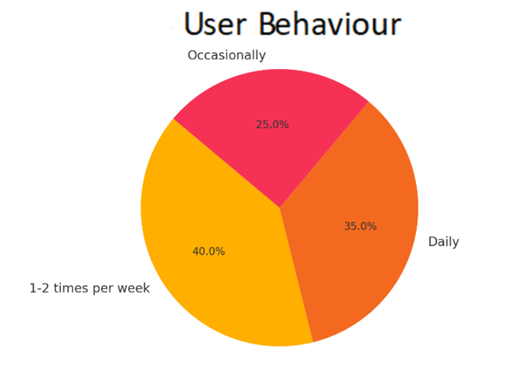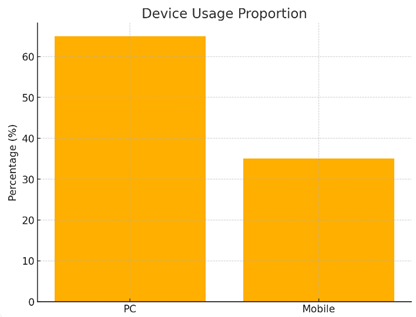172
社区成员
 发帖
发帖 与我相关
与我相关 我的任务
我的任务 分享
分享| Which course does this assignment belong to | 2401_Mu_SE_FZU |
|---|---|
| Where is the requirement for this assignment | Teamwork—Beta Sprint |
| Team name | “ExamMastery Pioneers” |
| The goal of this assignment | User Usage survey report |
With the rapid development of Internet products, user experience has become one of the important factors affecting the success of products. In order to better understand user needs and optimise our webpage, we conducted a usage survey for users. This report summarises the current situation and puts forward optimisation suggestions through detailed data analysis and user feedback, aiming to provide guidance for future product iterations.
Understand users’usage habits: including users’access frequency, main usage scenarios and device preferences, and average weekly usage time.
Identify users’pain points: collect users major problems and deficiencies in the process of webpage usage.
Mining user needs: Explore users’expectations for improvement of functions, design and services.
Online questionnaire: We designed a questionnaire containing 20 questions covering user behaviour, satisfaction and needs through Questionnaire Star.
User interviews: 10 users with exam revision needs were selected for one-on-one in-depth interviews to further explore users' real ideas and potential needs.
Behavioural data analysis: Combined with the user access logs of the webpage, analyse the user's behavioural path and residence time.
From 8th December 2024 to 15th December 2024, it lasted 7 days.
User composition: The survey recovered a total of 500 valid questionnaires, including 300 undergraduate users and 200 postgraduate users.
User characteristics: covering students waiting for graduate school and final exams as well as general learners.
Frequency of visits:
Normal users: 40% of the users visit 1-2 times a week, mainly when they need to get revision materials and example problems.
Daily users: 35% of the users visit the site more than once a day, mostly students who have been preparing for exams for a long time.
Low-frequency users: 25% of the users visit the website only when they have specific needs, such as students who are approaching the exam.

65% of users access primarily through PCs, as most content is better suited for viewing on large-screen devices.
35% of users access via mobile, mainly to view documents or quickly look up information in a fragmented period of time.

Overall rating: 4.2 points, users are generally satisfied with page loading speed and content quality.
PC user rating: 4.5 points, with a higher score, mainly attributed to the more reasonable page design and functional layout.
Mobile user rating: 3.8 points, with a relatively low score, due to the poor experience of some functions on mobile phones.
Comprehensive technical documentation: applicable to all kinds of developers and enterprise users.
Simple interface design: clear categorisation of information and prominent core functions.
Fast access speed: no obvious lag or loading delay.
Insufficient mobile adaptation:
Buttons and links click area is too small.
Interaction design is a bit complicated:
The entrance to some functions is not intuitive enough.
Lack of guidance for new users, high cost for new users.
Provide smarter search recommendation function to improve the search experience.
Enhance mobile optimisation and solve compatibility problems.
Add a user favourites function to facilitate users to save frequently used documents and contents.
Provide personalised theme and colour scheme options to meet different users' aesthetic needs.
Interface optimisation: make global adjustments to the mobile interface to ensure clear page layout and beautiful typography.
Function adaptation: expand the click area and optimise the interaction experience.
Performance improvement: accelerate the loading speed of mobile pages by technical means.
Add filtering function: Provide multi-dimensional filtering options (e.g. date, type, relevance, etc.).
Reorganise the function layout: display high-frequency functions in a centralised manner to reduce users' search costs.
New User Guide: Provide new users with concise function descriptions and operation guidelines.
Optimise button design: Improve the visibility and operability of buttons.
User favourites: support users to favourite and categorize frequently used content.
Content recommendation system: Recommends relevant content, such as technical articles or case studies, according to user behaviour.
Theme customisation: Support users to switch different theme styles according to their preferences.
Through this user usage survey, we gained an in-depth understanding of users' behavioural habits, satisfaction and needs for improvement. On the whole, users rate the loading speed and content quality of web pages highly, but there is still room for improvement in mobile adaptation, search function intelligence and interaction design. In the future, we will gradually optimise our products according to the survey results in order to enhance user experience and meet the needs of more scenarios.